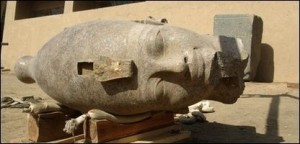[wp_campaign_1]
A colossal red granite head of one of Egypt’s most famous pharaohs has been unearthed in the southern city of Luxor, officials said.
The 3,000-year-old head of Amenhotep III – grandfather of Tutankhamun – was dug out of the ruins of the pharaoh’s mortuary temple.
Experts say it is the best preserved example of the king’s face ever found.
The 2.5m (8ft) head is part of a larger statue, most of which was found several years ago.
Antiquities officials say the statue is to be reconstructed.
“Other statues have always had something broken – the tip of the nose, or the face is eroded,” said Dr Hourig Sourouzian, who has led the Egyptian-European expedition at the site.
“But here, from the top of the crown to the chin, it is so beautifully carved and polished, nothing is broken.”
Egypt’s antiquities chief, Zahi Hawass, described it as “a masterpiece of highly artistic quality”.
Amenhotep III ruled Egypt from about 1387 to 1348 BC and presided over a vast empire stretching from Nubia in the south to Syria in the north.
Scientists using DNA tests and CT scans on several mummies have identified him as the grandfather of Tutankhamun – the boy-king born of an incestuous marriage between Akhenaten and his sister, both the offspring of Amenhotep III.
The massive mortuary temple in Luxor was largely destroyed, possibly by floods, and little remains of its walls.
[wp_campaign_1]



